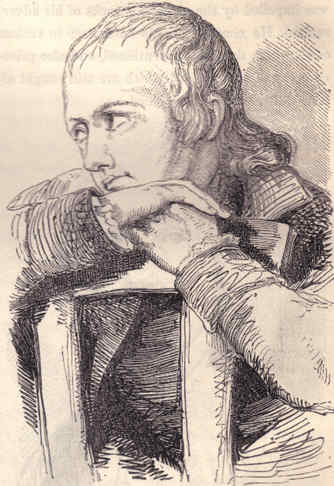|
RUNCIMAN, ALEXANDER,
a celebrated painter, the son of an architect, was born at Edinburgh in
1736. He early evinced a decided taste for drawing, and while yet a mere
boy employed himself almost constantly in sketching landscapes. In 1750
he was sent as an apprentice to Messrs. John and Robert Norrie,
house-painters in his native city, and under the instructions of the
former, whose mantle-piece decorations were much admired at the time, he
made rapid improvement. After studying as a pupil in the academy of the
brothers Foulis at Glasgow, he began, about 1755, to paint landscapes
professionally, and this department of art he pursued for about five
years with increasing reputation, but with little profit. In 1700 he was
induced to commence historical painting, a branch in which he found
greater encouragement than in portraying rural scenery. – His portrait
is subjoined.

[portrait of Alexander Runciman]
Having attracted the
notice of Sir James Clerk of Penicuick, baronet, then a chief patron of
Scottish art, he was, in 1766, sent by that gentleman to Italy, to study
the works of the great masters; and, while in that country, he made such
a good use of his opportunities as to excel many of his contemporaries,
particularly in the rich yet chastened style of colouring of the
Venetian school. He returned to Scotland in 1771, and the same year was
appointed, by the trustees for the Encouragement of Arts and
Manufactures, master of the academy established at Edinburgh for the
study of drawing, with a salary of £120. His principal work, of which
the design was entirely his own, was the paintings in the Hall of Ossian
at Penicuick. To this great undertaking he devoted himself so closely as
to contract an illness, from which he never recovered, from being
obliged to lie constantly on his back while decorating the ceiling with
scenes from Ossian’s Poems. These paintings, with the picture of ‘The
Ascension’ on the ceiling above the altar of the old Episcopal chapel,
Cowgate, Edinburgh; his ‘King Lear;’ his ‘Andromeda;’ and his ‘Agrippina
landing with the Ashes of Germanicus,’ fully established his fame as an
historical painter. He executed several other pieces, of most of which
engravings were published. He died October 21, 1785, dropping down
suddenly on the street, when about to enter his lodgings. His brother,
John Runciman, was also a painter of some eminence in his day. |

